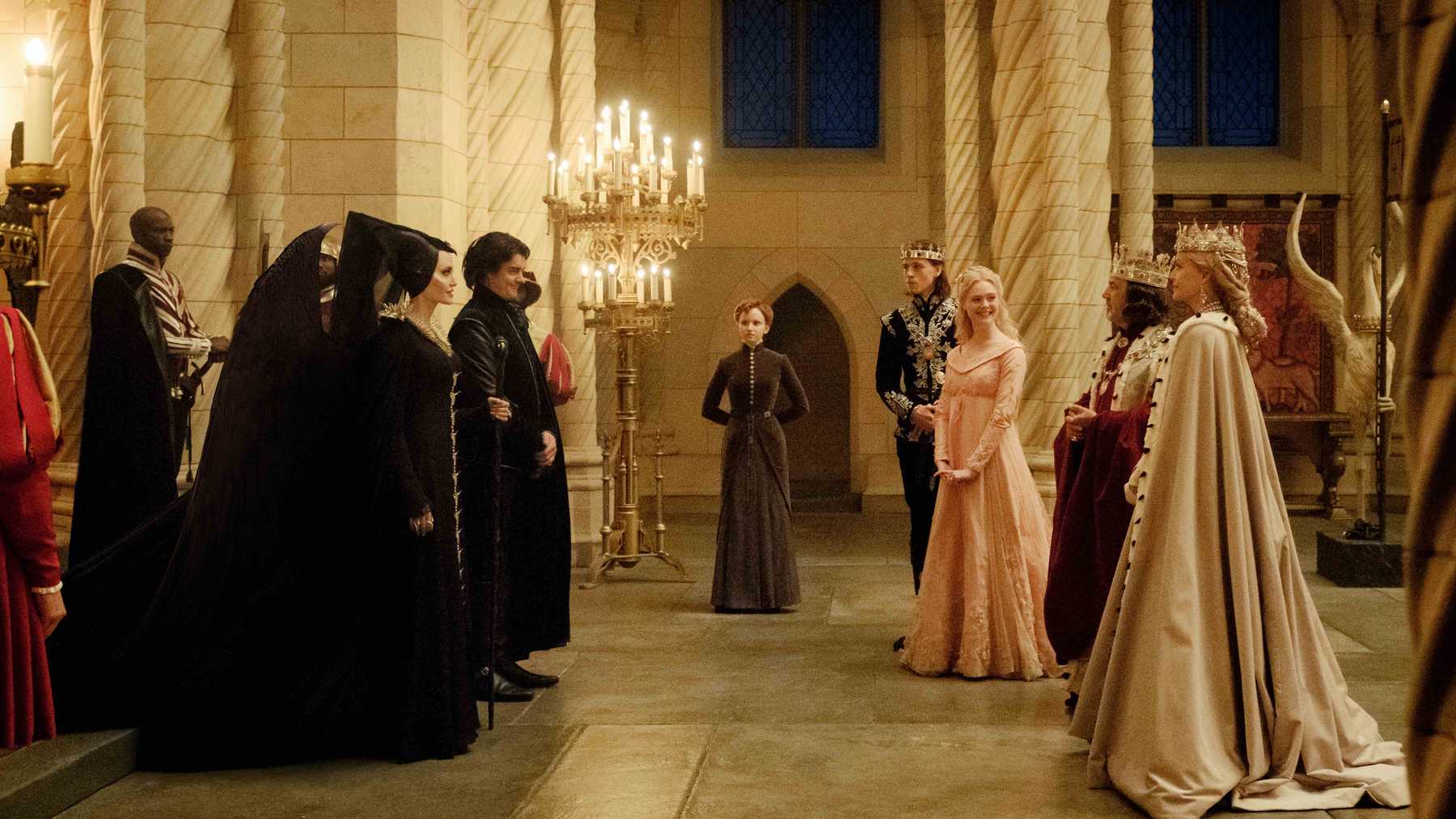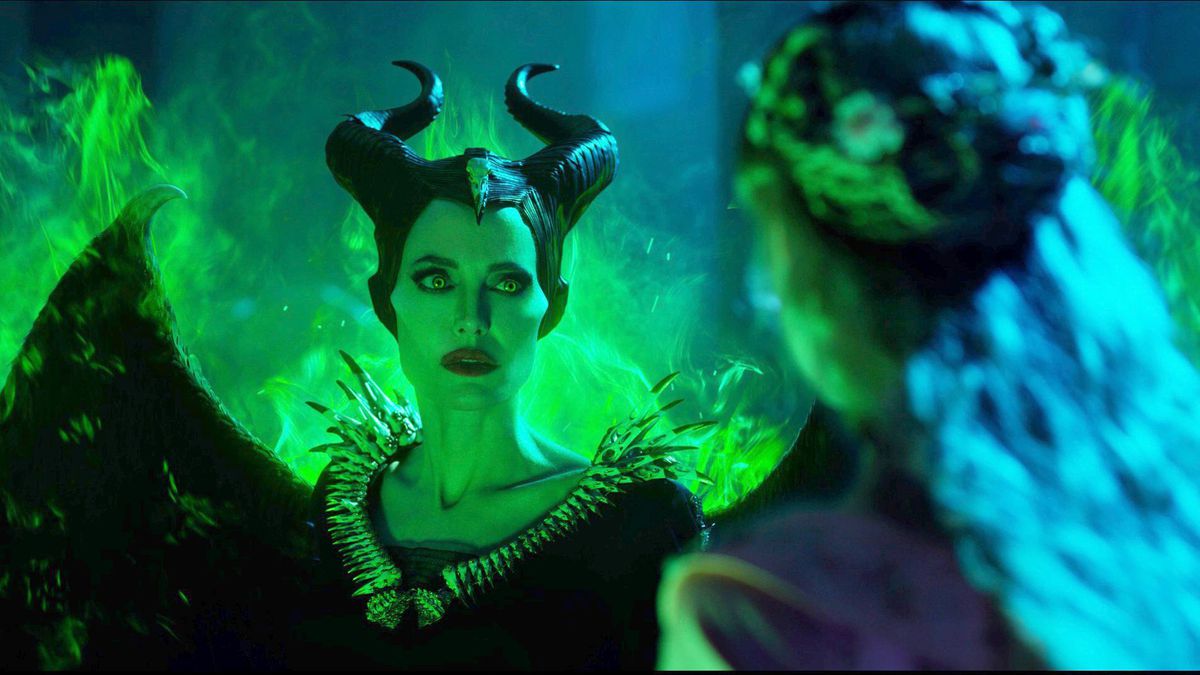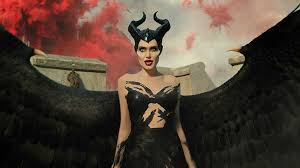There are many striking visuals in Joachim Rønning’s Maleficent: Mistress of Evil, perhaps none more so than Maleficent herself. Angelina Jolie has always been a preternatural creature, whose eyes have an alien sort of piercing intensity, further accentuated here by green contact lenses. With spiral horns, enormous black wings and cheek bones that look like she’s swallowing a small surfboard, Jolie becomes even more otherworldly, and it’s impossible to remove your gaze from this stimulus. She looms over and frequently buzzes the treetops of a glittering digital kingdom that has castles, waterfalls, marshes, rolling plains, sprites and other woodland creatures who are nearly as fantastic as she is.
Ten years ago, this would have been the most amazing movie you’d ever seen. Not because the plot was anything worth writing home about, but because in that particular era of digital innovation, plot could take a back seat when your eyes were being so tickled. Ten years ago was, in fact, when the plot-deficient Avatar was released, so it’s no coincidence (actually, it probably is a coincidence) that some of the flying scenes here seem to call back to that seminal landmark moment in 3D technology. That a movie can look almost as good as Avatar 12 times a year nowadays is an indication of what we as moviegoers have gained on a superficial level, but lost on a level that’s far more profound.
And the plot isn’t going to save us. Maleficent 2, if we are referring to it disrespectfully, is a particular sort of symbol of what we’ve lost as fans of screenwriting. It’s about the furthest thing from an original screenplay, which is funny because it is, technically, an original screenplay. But it’s an original screenplay that’s a sequel to a reboot, which was really a reimagining of a villainous character from a classic Disney movie. It’s got theme park sensibilities, so it’s no surprise it often feels like a ride. But rides rarely have interesting stories either.
The title character, who was redeemed by the events of the 2014 original, is back in the doghouse as the boogeyman again. Five years later, history only remembers that she put a curse on a princess, not that she saved the princess from that curse and raised her as her own daughter. That princess (Elle Fanning), now promoted to queen of the kingdom’s outerlying “moorlands,” has accepted an engagement from the kingdom’s prince (Harris Dickinson), her love interest since the first film. That involves Maleficent and the current queen, Ingrith (Michelle Pfeiffer), making nice over a celebratory dinner. Nice they can’t make, but that’s primarily because Ingrith has larger plans that involve undermining her own husband and once again framing Maleficent. After all, history only remembers that the woman with black wings and horns is the villain.
It’s not that the story of Maleficent: Mistress of Evil in particular is uninspired, because it seems like a logical place to take these characters, but that the whole framework is now so familiar as to become shrug-worthy. There’s the inevitable break between Maleficent and Princess Aurora, where Aurora blames Maleficent for the dinner escalating into violence, and then an unsurprising refuge for Maleficent among others of her species, who have been at war with the world of humans, but whom Maleficent apparently never knew existed. (This is never satisfactorily explained.) Maleficent is torn between those of her kind and the one she raised as a daughter, and the ice queen’s plans place all the sprites and other woodland creatures in danger. Jolie does a lot of acting in these scenes just by small adjustments in her gaze, which is both a case of admirable minimalism, and completely out of scale with the rest of the production.
It’s the other alpha who is really the problem here. Twenty nineteen has treated us to an array of complicated villains, from Thanos to the Joker, but what makes the utter conventionality of Pfeiffer’s Ingrith even worse is that the premise of this Maleficent series involves finding unexpected textures in a villain conceived as one-dimensional. Maleficent has become more interesting over the course of two movies, but now there’s a new one-note villain for us to deal with in her place. Pfeiffer has really taken to the phase of her career where she plays terrible people, but her skills really shine in a movie like mother!, where she displays a sort of social insidiousness that defies easy description. There’s nothing but easy description to Ingrith’s malevolence, which the movie telegraphs from her very first line of dialogue. The rest is just Pfeiffer leaning into a century’s worth of trite villain tropes.
If the women here are alphas, these are about as beta men as you can imagine. They’ve graduated from evil in the first film to just plain ineffectual here. Harris Dickinson in particular seems to have been cast for his milquetoast personality. You might as well call him Prince Bland. Aussie actor Brenton Thwaites played this character in the first movie, and I’m sure his replacement by Dickinson was not primarily to make the character more drippy, but that’s been the effect. As the king is sidelined in a curse for much of the movie as well, it really is left to the women to fight it out, as the queen’s henchwoman is a fourth woman with agency superior to the men, a skilled archer played by Jenn Murray. The men do get some representation (Chiwetel Ejiofor, Ed Skrein) among the fairies of Maleficent’s species, but this is really the women’s show, for better or worse.
More often than not, it’s for worse. And yet in a series that is about redemption, Maleficent: Mistress of Evil actually sort of redeems itself in its third act. The big final battle, which has become so tedious in Disney’s string of Marvel movies, actually recalls another Disney property with an effective climax, Star Wars: The Last Jedi. That could just be because the explosions of red dust are reminiscent of the surface of the planet that played host to The Last Jedi’s final standoff, but it’s nice to see nonetheless. It’s not only a fondness for better movies that gives this scene life, though, as there is one unexpected turn of events that is effectively played for real drama. It’s quickly followed by the most magnificent moment in the film.
And yet, a second time, it’s impossible to escape the conclusion that Maleficent, as a series, is spinning its wheels. The first movie was ahead of its time in terms of its feminism lite, trying to complicate an uncomplicated portrayal of a wicked witch, and place the men who made her that way in its crosshairs. This sequel has given us a villain who’s worse than the original Maleficent ever was, muddying that sense of progress. Maybe Maleficent 3 will be the redemption of Ingrith.


